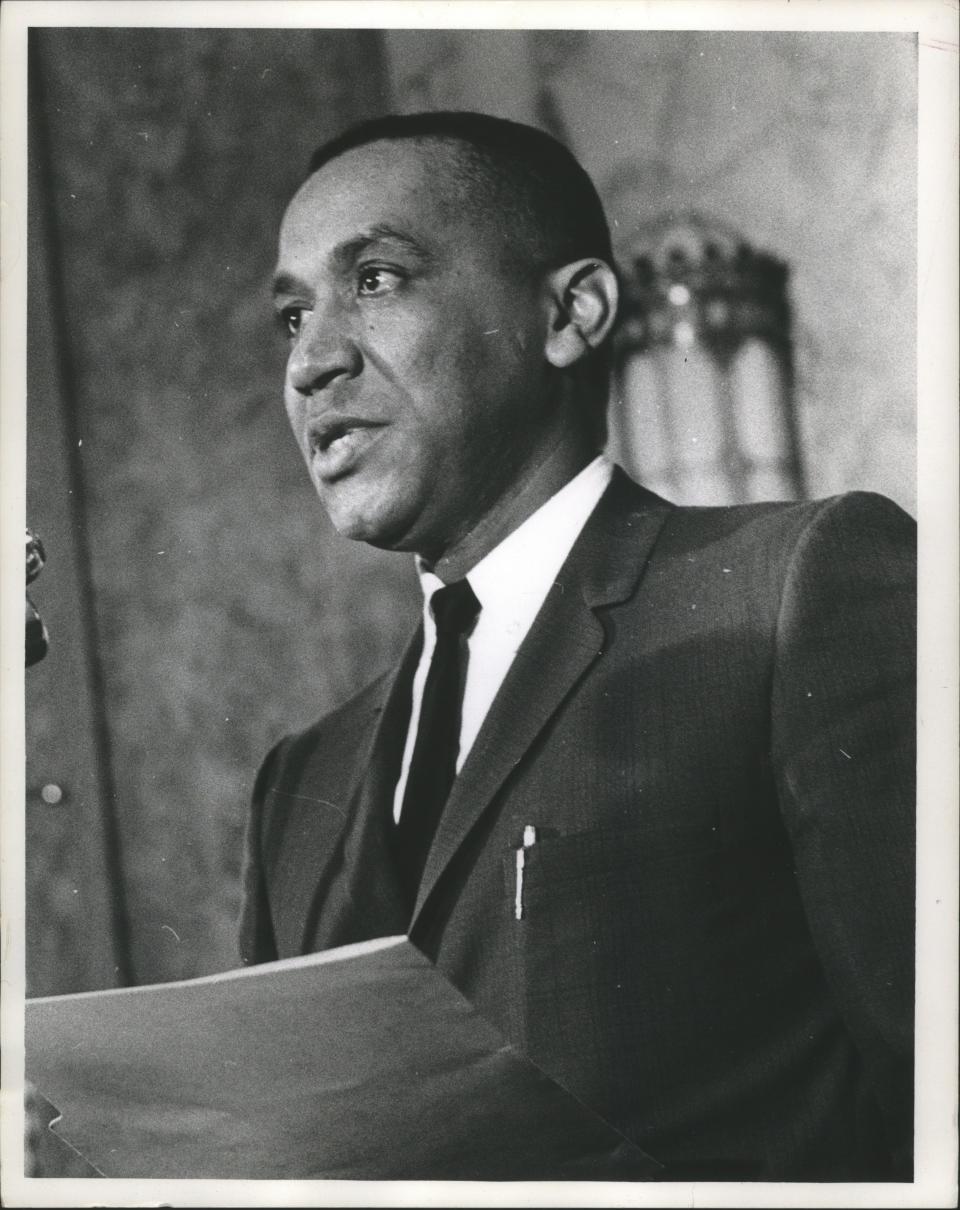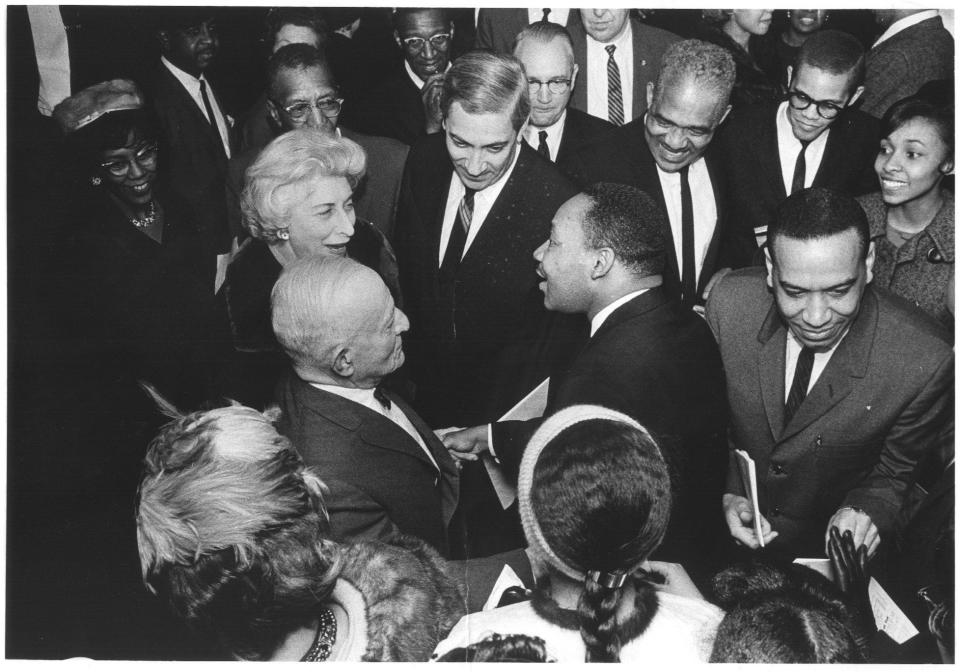Bronzeville District street in Milwaukee renamed for Black pioneer Dr. William Finlayson
- Oops!Something went wrong.Please try again later.
The Milwaukee road between West Capitol Drive and West Walnut Street — formerly North 5th Street — will now be known as Dr. William Finlayson Street.
Finlayson, a beloved obstetrician and gynecologist who practiced for nearly 40 years, welcomed thousands of infants into the world. The Florida-born doctor became the first Black OB-GYN to work at St. Joseph Hospital, now Ascension Southeast Wisconsin Hospital - St. Joseph.
In addition to delivering thousands of infants, Finlayson was a champion for eliminating housing discrimination, financial literacy and preserving Black history.
In light of his indelible impact on the community, the Common Council voted Tuesday to rename the street in honor of Finlayson, where Alderman Russell Stamper III described Finlayson as a legend in the city, county and the country.

Alderwoman Milele Coggs echoed that sentiment, saying, “The impact and influence of Dr. Finlayson is felt through the life and works of so many people in the city of Milwaukee, and I am honored to have a street in Bronzeville named after him.”
Early influences shaped Finlayson’s path
Although he was born in 1924, during an era in which overt racism hindered the advancement of many African Americans, Finlayson's success was, in many ways, predictable because of his personal drive and early influences, according to an oral history he delivered in 2008.
Finlayson's mother, Alba, had completed multiple years of college and taught in Orlando at Jones High School. His father, James, was a respected and well-known Baptish preacher. In elementary school, one of his teachers was the Black inventor and scientist George Washington Carver. And one of his childhood friends at Campbell High School was a girl who would grow up to found the Bethune-Cookman University, Mary McLeod Bethune.
Surrounded by these influences, Finlayson excelled educationally, attending Florida A&M, the historically Black college of his two older sisters, at the age of 16.
He spent two years there, pledging to Alpha Phi Alpha Fraternity, before serving in the U.S. Army for two years. There, he taught illiterate Black soldiers at Fort Benning, Georgia how to read, and he received a promotion to 2nd Lieutenant.
While serving in the Army reserves between 1946 to 1953, Finlayson also attended Atlanta's Morehouse College, where he was classmates with Dr. Martin Luther King Jr.
Finlayson made Milwaukee home
After changing his initial business major, Finlayson graduated from Morehouse College as a pre-med student in 1948. He took a year to work with his half brother waiting tables in dining cars on the Ohio Railroad, before returning to his studies at Meharry Medical College.
By 1957, Finlayson had been mentored by obstretecian Carr Treherne, and began his residency at the University of Minnesota Medical School. When he graduated, he had three choices of where to go: Chicago, Atlanta or Milwaukee.
He chose Milwaukee.
In Milwaukee, he began practicing at St. Joseph Hospital, Mt. Sinai Hospital and the University of Wisconsin Medical School. And with a group of other doctors — Walter White, Randall Pollard, George Hillard, and Gerald Poindexter — he opened a private practice.
He made the move to Milwaukee with his late wife, Edith, who later received a Congressional recognition for her work in Milwaukee. Edith, also the child of a Baptist minister, became the first Black member on the University of Wisconsin’s Board of Regents and the first Black nurse at Milwaukee’s Veterans Administration. Edith was also active with the Greater Milwaukee Committee, Milwaukee Area Technical College, National Council of Christians and Jews, Milwaukee Urban League, NAACP and the Milwaukee Regional Medical Center.
But almost immediately, they encountered discrimination.
Like other Black doctors, Finlyason was initally barred from treating white patients. He was also turned down when he tried to purchase a lot in an exclusively white neighborhood, leading him to join fair housing marches led by Alderwoman Vel Phillips and Father James Groppi in the 1960s.
He even invited his former classmate, King, to speak in Milwaukee. As Coggs noted, “(Finlayson) was instrumental in helping to bring MLK to the city of Milwaukee oftentimes.”

Finlayson also founded the city's first Black-owned bank, North Milwaukee State Bank, in 1971 and served for several years on the bank's board. He founded the W.E.B. Du Bois Club to educate high school students with financial skills and Black history, even visiting Ghana, the last country Du Bois called home.
Througout his career, Finlayson served as president of the Cream City Medical Society, Milwaukee Gynecological Society and his local YMCA Board. He also served as vice president of United Community Services (now United Way of Greated Milwaukee & Waukesha County), a delegate to the Wisconsin Medical Society, and a member of the National Urban League and was a lifetime NAACP member.
Finlayson officially retired from his practice after 39 years working with patients.
The streets once home to his practice now host other culturally significant organizations: the Greater Milwaukee Urban League is located where is practice used to be on North 5th Street and West North Avenue while the WNOV radio station took the place of his practice on North 20th Street and West Capitol Drive.
The elevation of Finlayson's name follows other efforts to highlight the contributions of Black pioneers, including the streets renamed to honor Dr. Martin Luther King Jr. and Vel R Phillips and the Milwaukee Fire Department’s recognition of architect Alonzo Robinson Jr.
However, Coggs said this particular street renaming was made more special by Finlayson’s presence.
“We get the chance to give Dr. Finalyson his flowers while he is here,” Coggs remarked. “At 98 years young, I am proud that we have the opportunity for him to witness and know the appreciation that so many of us have for the contirbutions he has made in the lives of so many.”
Finlayson was present at the vote along with his daughter and two sons — Sheila, Reginald and James — as well as several prominent Milwaukeeans including his fraternity brother Andre Ashe and Pastor Reverend Monk of Ephesians Missionary Baptist Church.
More:Milwaukee Bucks add 'Gathering Place' blue jerseys to 2022-23 uniform collection
Our subscribers make this reporting possible. Please consider supporting local journalism by subscribing to the Journal Sentinel at jsonline.com/deal.
DOWNLOAD THE APP: Get the latest news, sports and more
This article originally appeared on Milwaukee Journal Sentinel: Bronzeville District street named for Black pioneer William Finlayson

